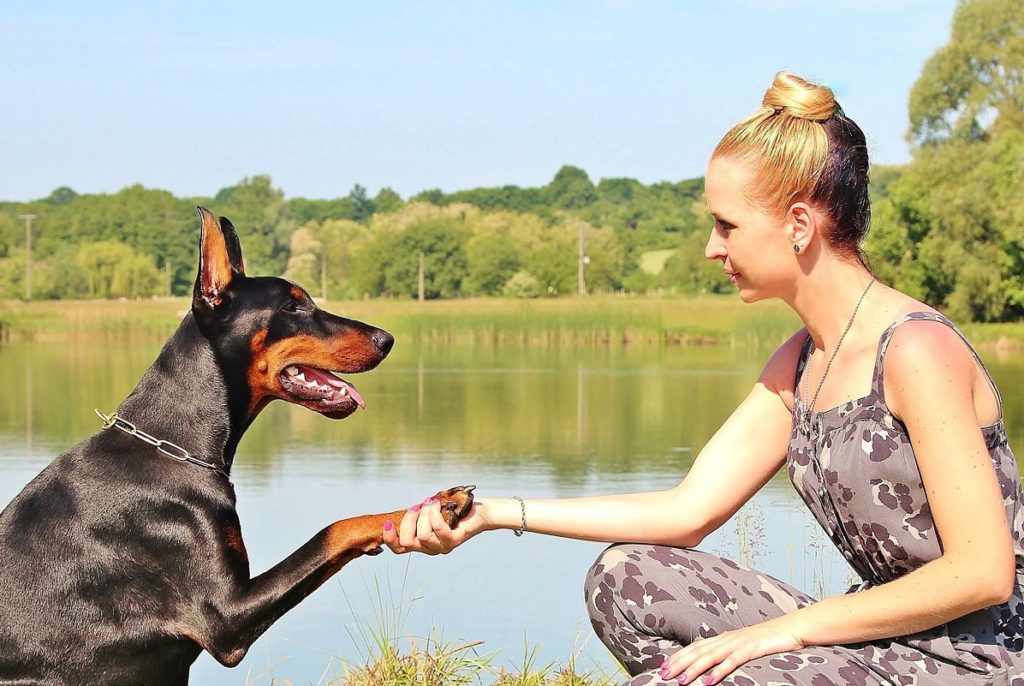Training is an important part of owning a dog. It gives your pup mental stimulation and can teach crucial commands for their safety such as come or stay. However, not all dog training needs to be serious and you may choose to teach your dog just a few tricks. If teaching your dog to shake is on your list, fortunately, it is an easy trick to do for most dogs to learn. According to the American Kennel Club (AKC), there are two primary methods for training a dog to shake. However, it is important to recognize that some trainers have differentiating processes.
How to Train a Dog to Shake
 The AKC recognizes two methods on how to train a dog shake. The first is known as “waiting it out” and the second is “tap tap tap.” Both processes are effective, so use whatever you feel comfortable with or the method you believe your pup will respond to best.
The AKC recognizes two methods on how to train a dog shake. The first is known as “waiting it out” and the second is “tap tap tap.” Both processes are effective, so use whatever you feel comfortable with or the method you believe your pup will respond to best.
Waiting It Out
For this method, follow these simple steps:
- Hold your empty hand, palm up, in front of your dog at about his knee height.
- Then just wait. Instinctively, your dog will begin to sniff and lick at your hand and, eventually, he will try other tactics such as pawing.
- When your dog lifts his paw, praise him with phrases like “good dog,” regardless of whether or not he has made contact, and reward him with a treat.
- Repeat this process until your dog is consistently lifting his paw into your hand when it is placed in front of him. Then start adding a verbal cue like “shake” as you present your hand to him.
Tap Tap Tap
Equally simple to the above is the AKC’s second method. To train your dog to shake utilizing this method, follow these few steps:
- Using your finger, gently tap the back of your dog’s paw just under his dew claw (the little nail on the upper, inner part of a dog’s foot).
- As a natural response, your dog will lift her paw to move it away from the tapping. If she does not lift immediately, keep gently tapping the back of her paw until she does.
- As soon as she begins to lift her paw, sweep your hand forward and it up in your hand.
- Verbally praise and reward your dog with a treat.
- Repeat this process until your dog consistently lifts his paw as you reach for it. Only then can you add in the verbal cue of “shake.”
Tips and Tricks for Training
 Training a dog takes patience and consistency in order to achieve results, know that going in. But there are also a few tips and tricks you should know that will help facilitate the training process and keep your pup motivated and engaged.
Training a dog takes patience and consistency in order to achieve results, know that going in. But there are also a few tips and tricks you should know that will help facilitate the training process and keep your pup motivated and engaged.
- Dogs Don’t Generalize Unfortunately, dogs do not generalize well, which means that just because your pup knows how to shake with his right paw, doesn’t mean he knows how to do it with his left. If you want your dog to be able to shake with both paws, you will have to go through the process above with each foot. You may even choose to differentiate paws with distinctive commands, like “shake” for right and “paw” for left.
- Keep Sessions Short Training for 5-10 minutes at a time is plenty for you and your dog. Keeping your sessions short helps to maintain you and your dog’s patience as your pup may become frustrated if he isn’t getting his treats.
- Avoid Excessively Chewy Treats You will want to reward your dog with treats that can be chewed relatively quickly or you will spend the majority of your training sessions waiting for him to finish eating his reward.
- End on a Positive Note Just as it sounds, you should try to end all sessions on a positive note for your dog so he remains confident and calm. If you are becoming frustrated or your dog doesn’t seem to be “getting it,” go back to a command he does know and reward him for that before ending the session.
Remember to practice commands with him on a regular and frequent basis until he is performing his tricks consistently on command. With some patience and practice, your dog will be shaking your hand in no time at all.




